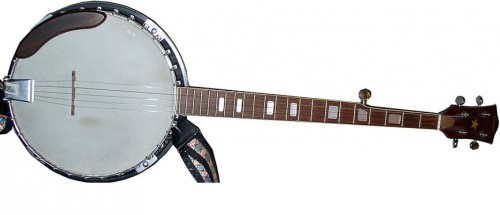
Five string banjo showing the position of the bridge on the round head. (CC BY-SA 3.0 / DMacks)
By Tushna Commissariat and Hamish Johnston
Folk and country music often blends the sharp twang of a banjo with the mellow and sustained tone of a guitar. While the two instruments appear to be very similar – at least at first glance – they have very different sounds. This has long puzzled some physicists, including Nobel laureate David Politzer, who may have just solved this acoustical mystery.
In both guitar and banjo, the strings are stretched between the “bridge” and “nut”. A guitar bridge is fixed to the large piece of wood that comprises the “top” of the instrument whereas a banjo bridge is mounted on the much thinner “head”, which is essentially the top of a drum.
When a string is plucked, the amplitude of vibration of a banjo head is much greater than that of a guitar top – which probably explains why the banjo is so loud. Politzer, who plays and restores banjos in his spare time, has written a paper arguing that the vibrating head is what gives the banjo its distinctive sound.
The basic idea is that the up-and-down motion of the bridge modulates the tension of the string and therefore the frequency of the sound it emits. Politzer used mathematical and audio software to show that the result of this frequency modulation is the distinctive timbre of the instrument. You can read more about his analysis on the arXiv blog and Politzer’s paper is entitled “Banjo timbre from string stretching and frequency modulation”.
Elsewhere on the Web this week, we came across an article on the Nature News website that really made us smile. In it, Kerri Smith talks about romances that blossom in laboratories and research groups and conferences across the world of science. The very first anecdote narrated involves two physicists who did not agree on their research initially, but found each other agreeable in every other way! Find out how their story ends and read about others on the Nature website.
Also, do take a look at the stunning images and videos to have won this year’s International Earth and Sky photo contest, organized by The World at Night (TWAN). With the aim of having a stunning terrestrial view to match a celestial roof in each image, the contest has participants from all over the globe. From a young boy looking at the Milky Way from the Egyptian desert to a mountain bathed in the Northern Lights in Iceland, these stunning entries will captivate you.
And in more weekend fun, find out what time travel and real estate have in common and take a look at this video of physicists Jon Butterworth and Brian Cox talking about the discovery of the Higgs boson at the Royal Institute.
Guidelines
Show/hide formatting guidelines
this text was deletedwhere people live in harmony with nature and animals</q>
Some text